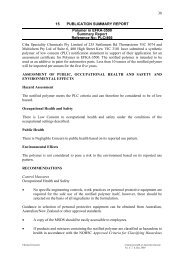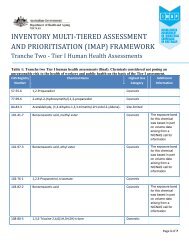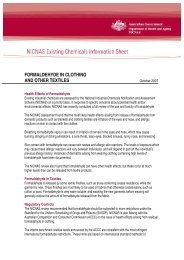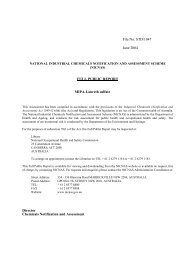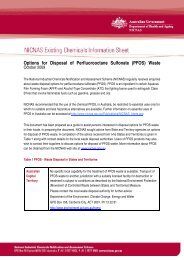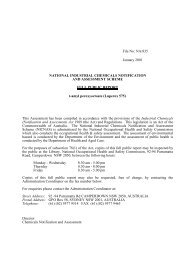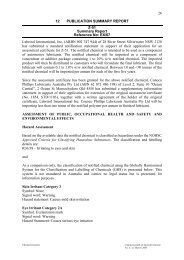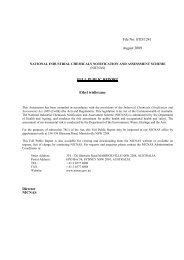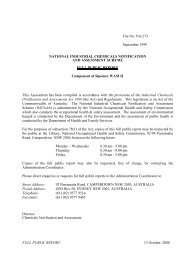1,4-Butanediol - NICNAS
1,4-Butanediol - NICNAS
1,4-Butanediol - NICNAS
You also want an ePaper? Increase the reach of your titles
YUMPU automatically turns print PDFs into web optimized ePapers that Google loves.
<strong>NICNAS</strong> Existing Chemicals Information Sheet<br />
1,4-<strong>Butanediol</strong> CAS No: 110-63-4 June 2009<br />
Introduction<br />
1,4-<strong>Butanediol</strong> is an industrial solvent and intermediate used in the production of various plastics and polymers.<br />
When ingested, it is rapidly absorbed and metabolised to form gamma-hydroxybutyrate (GHB),<br />
a neuromodulator that exerts potent depressant effects on the central nervous system.<br />
Concerns regarding the toxicity of 1,4-butanediol have been raised with <strong>NICNAS</strong> through public enquiries<br />
and the media, after the hospitalisation of children who ingested toy beads that were found to contain<br />
1,4-butanediol. These enquiries prompted <strong>NICNAS</strong> to investigate the use and safety of 1,4-butanediol in<br />
Australia and the adequacy of current regulatory controls. This Information Sheet presents the major findings<br />
of the health hazard assessment report available on the <strong>NICNAS</strong> website 1 .<br />
Chemical Identity<br />
Common name: 1,4-<strong>Butanediol</strong><br />
Structural formula:<br />
H0<br />
CAS registry number: 110-63-4<br />
IUPAC chemical name: Butane-1,4-diol<br />
1,4-<strong>Butanediol</strong> is a colourless, viscous and almost odourless liquid.<br />
Import, Manufacture and Use of 1,4-<strong>Butanediol</strong> in Australia<br />
1,4-<strong>Butanediol</strong> is listed on the <strong>NICNAS</strong> High Volume Industrial Chemicals List (HVICL). Over the year 2001-02,<br />
import volumes totalling greater than 1000 tonnes were reported. The major uses of 1,4-butanediol, as reported<br />
by the Plastics and Chemicals Industries Association (PACIA) in 2005, are as an intermediate and chain extender<br />
in the production of urethane prepolymers, polyether diols, polyester polymers (particularly polybutylene<br />
terephthalate) and in the manufacture of tetrahydrofuran 2 . It is also used as a plasticiser<br />
(eg. in polyesters and cellulosics), as a carrier solvent in printing ink, a cleaning agent, an adhesive<br />
(in leather, plastics, polyester laminates and polyurethane footwear), in agricultural and veterinary chemicals<br />
and in coatings (in paints, varnishes and films).<br />
1 http://www.nicnas.gov.au/Publications/CAR/Other/1,4-butandediol_Hazard_Assessment_PDF.pdf<br />
2 Personal communication, 5 December 2007<br />
National Industrial Chemicals Notification and Assessment Scheme<br />
GPO Box 58 Sydney NSW 2001 Australia, T +61 2 8577 8800, F +61 2 8577 8888 www.nicnas.gov.au<br />
0H<br />
1
<strong>NICNAS</strong> Existing Chemicals Information Sheet<br />
1,4-<strong>Butanediol</strong> is also reportedly used as a solvent in cosmetic formulations and as a humectant in<br />
pharmaceuticals.<br />
1,4-<strong>Butanediol</strong> is imported as a solid wax (99.5% purity) in 200L steel drums and also in formulated materials.<br />
It is onsold in the same drums, decanted in 20L containers or formulated into blends (in various pack sizes)<br />
from which the 1,4-butanediol can be readily recovered.<br />
Potential Exposure to 1,4-<strong>Butanediol</strong><br />
Limited information about the presence of 1,4-butanediol in consumer products was found in the<br />
literature. In Europe, 1,4-butanediol is used as an ingredient in deodorants and listed as a solvent in the<br />
International Cosmetic Ingredient Dictionary and Handbook. It is also used as a humectant, in pharmaceuticals<br />
and in cosmetic pencils (Household Products Database 3 ).<br />
The Hazardous Substances Databank (HSDB 4 ) reports that 1,4-butanediol was identified at a high concentration<br />
in the indoor air of new and recently renovated buildings in Switzerland. Therefore, people living and working<br />
in new buildings may be exposed to the chemical through inhalation of contaminated air.<br />
Summary of Key Health Issues<br />
The toxicity of 1,4-butanediol appears to be restricted to acute toxicity and slight skin, eye and respiratory<br />
tract irritation. From repeated dose studies, it is evident that the most sensitive adverse effect is neurotoxicity.<br />
Overall, the short duration and nature of the available studies do not allow for the identification of a<br />
robust dose-response and No-Observed-Adverse-Effect-Level (NOAEL). There are no data to indicate that<br />
1,4-butanediol is a skin sensitiser, genotoxic, carcinogenic, or a reproductive toxicant.<br />
Current Regulatory Status<br />
1,4-butanediol IS listed in:<br />
• the Australian Inventory of Chemical Substances (AICS) and<br />
• the National Drugs and Poisons Schedule Committee Standard for the Uniform Scheduling of Drugs<br />
and Poisons (SUSDP 5 ). The non-polymerised form of 1,4- butanediol for all domestic use (including<br />
toys) is listed in Appendix C. Appendix C lists substances, other than those included in Schedule 9<br />
(prohibited substances), considered to be of such danger to health as to warrant prohibition of sale,<br />
supply and use.<br />
1,4-butanediol IS captured by:<br />
• the industry-based PACIA ‘Code of Practice for Supply Diversion to Illicit Drug Manufacture’.<br />
This Code has been developed in consultation with law enforcement authorities to control supply<br />
of certain substances, including 1,4-butanediol now listed as an Illicit Drug Precursor (Category 1).<br />
Three Australian states (NSW, Qld and WA) have legislated to make elements of the PACIA Code<br />
mandatory and other states are also developing regulations.<br />
3 http://householdproducts.nlm.nih.gov<br />
4 http://toxnet.nlm.nih.gov/cgi-bin/sis/htmlgen?HSDB<br />
5 http://www.tga.gov.au/ndpsc/susdp.htm#susdp<br />
National Industrial Chemicals Notification and Assessment Scheme<br />
GPO Box 58 Sydney NSW 2001 Australia, T +61 2 8577 8800, F +61 2 8577 8888 www.nicnas.gov.au<br />
2
<strong>NICNAS</strong> Existing Chemicals Information Sheet<br />
1,4-butanediol is NOT listed in:<br />
• the Hazardous Substances Information System (HSIS), and<br />
• the Australian Customs (Prohibited Imports) regulations which cover the import/export of drugs<br />
and certain precursor substances used in the manufacture of illicit drugs. However, GHB 6 is classified<br />
as a psychotropic substance and listed as a prohibited import that requires import authorisation.<br />
Health and Safety Information<br />
The major source of the information about health effects is a report prepared under the Organisation<br />
for Economic Co-operation and Development (OECD) Screening Information Data Set (SIDS) Program.<br />
The SIDS Initial Assessment Report (SIAR) on 1,4-butanediol, finalised in 2000, was the primary reference<br />
material. A comprehensive literature search was carried out for data published since 1999 to ensure that those<br />
studies published after the last literature search conducted for the SIAR were also reviewed and summarised<br />
in the <strong>NICNAS</strong> report.<br />
After oral or intravenous administration, 1,4-butanediol is rapidly and efficiently metabolised in the liver<br />
to form GHB. In humans, extensive conversion of 1,4-butanediol to GHB after oral dosing indicated that<br />
ingestion of 1,4-butanediol is essentially equivalent to GHB intake. Peak blood levels are achieved after<br />
30 to 60 minutes.<br />
No data are available on dermal absorption.<br />
Animal Data<br />
Acute Toxicity<br />
1,4-<strong>Butanediol</strong> is considered to be moderately toxic by the oral route and has low toxicity by the dermal<br />
and inhalation routes. The lowest reported LD50 (Lethal Dose, 50%; ie. the dose that is lethal for half of the<br />
animals tested) value is 1200 mg/kg bw (body weight) in guinea pigs. In rats and mice, reported values are in<br />
the range of 1525-1830 mg/kg bw and 2060 mg/kg bw respectively.<br />
Irritation<br />
Eyes and Skin – In rabbits, 1,4-butanediol is not irritating to the skin and at most considered only a slight<br />
irritant to the eyes.<br />
Inhalation – Slight respiratory irritation has been observed in rats following exposure to an aerosol of<br />
1,4-butanediol at concentrations higher than 4.6 mg/L.<br />
Sensitisation<br />
A study in guinea pigs showed no skin sensitising potential.<br />
Repeated Dose Toxicity<br />
In a 10-day oral (gavage) study in mice, a NOAEL of 100 mg/kg bw/day was established for signs of central<br />
nervous system intoxication including hypoactivity, immobility, loss of righting reflex and prone posture. Similar<br />
neurotoxicity was seen in rats in a 39 to 45-day gavage study from 200 mg/kg bw/day with full recovery noted<br />
within 5 hours of dosing. In an inhalation study, reduced body weight, increased erythrocyte counts and other<br />
blood values and slight atrophy of lymphoid cells in the thymus were seen from 5 mg/L (4h) with the body<br />
weights and thymic atrophy returning to normal during a 14-day recovery period.<br />
6 Gamma-hydroxybutyrate, see lntroduction, page 1.<br />
National Industrial Chemicals Notification and Assessment Scheme<br />
GPO Box 58 Sydney NSW 2001 Australia, T +61 2 8577 8800, F +61 2 8577 8888 www.nicnas.gov.au<br />
3
<strong>NICNAS</strong> Existing Chemicals Information Sheet<br />
Neurotoxicity<br />
Adverse effects of 1,4-butanediol on the nervous system have been observed in acute studies. The chemical<br />
appears to have dual toxicological actions: the major neurotoxic effects of 1,4-butanediol are attributable<br />
both to its conversion to GHB and its alcohol-like effect due to the diol itself. Administration of 496 mg/<br />
kg bw 1,4-butanediol to rats caused CNS 7 depression and induced a state resembling sleep or anesthesia<br />
characterised by loss of righting reflex, struggle response and voluntary motor activity. Very similar<br />
neurotoxicologic responses were observed after administration of GHB.<br />
Genotoxicity<br />
1,4-<strong>Butanediol</strong> was negative in an Ames (bacterial mutation) test, a gene mutation and two chromosomal<br />
aberration tests in mammalian cells. The only in vivo study available was judged to be unreliable although<br />
a negative result was obtained. Overall, 1,4-butanediol is not considered to interact with DNA.<br />
Carcinogenicity<br />
Although 1,4-butanediol has not been evaluated for carcinogenicity, Y-butyrolactone which, like 1,4-butanediol,<br />
is rapidly converted to GHB, has shown no carcinogenic response in rats and mice over a 2-year period. Based<br />
on the absence of evidence for genotoxicity of 1,4-butanediol and the negative result of the carcinogenicity<br />
bioassay for a related compound, 1,4-butanediol is not considered to be carcinogenic in animals.<br />
Reproductive Toxicity<br />
No effect on fertility was seen in a study in male and female rats administered up to 800 mg/kg bw/day<br />
1,4-butanediol. In a developmental toxicity study in the mouse using doses of 100 to 600 mg/kg bw/day,<br />
a slight reduction in live foetal weight was seen from 300 mg/kg bw/day in the presence of maternal toxicity.<br />
At 100 mg/kg bw/day no developmental toxicity was seen. Therefore, 1,4-butanediol is not considered<br />
a developmental toxicant, as the developmental effects seen were a secondary non-specific consequence<br />
of maternal toxicity.<br />
Human Data<br />
Acute toxicity<br />
The critical toxic effect of 1,4-butanediol is neurotoxicity. Central nervous system disturbances including<br />
decreased alertness, dizziness and respiratory depression have been reported following oral dosing at<br />
25 mg/kg bw. More significant effects occur at higher doses and by other routes of administration with sleep<br />
induction, restlessness and myoclonus (a quick, involuntary twitching of a muscle or muscle group) reported<br />
to occur following intravenous administration of 30 mg/kg bw and miosis (constriction of the pupil of the eye),<br />
areflexia (absence of reflexes), coma and death observed in patients after rectal administration of 15 or 30g<br />
1,4-butanediol (estimated at 200 or 400 mg/kg bw).<br />
Experience with human exposure – case studies<br />
Numerous case reports are available that describe the neurological consequences (including agitation,<br />
combativeness, respiratory depression, a labile 8 level of consciousness, vomiting, seizures and death)<br />
in patients known to have ingested illicit products containing 1,4-butanediol. The inability to accurately<br />
determine the dose of 1,4-butanediol ingested - and the co-exposure to other chemicals present at unreported<br />
concentration in these products in many cases - means that it is not possible to correlate the degree of<br />
1,4-butanediol exposure with the severity of neurotoxicity from these reports.<br />
7 Central nervous system<br />
8 Imbalanced or unbalanced<br />
National Industrial Chemicals Notification and Assessment Scheme<br />
GPO Box 58 Sydney NSW 2001 Australia, T +61 2 8577 8800, F +61 2 8577 8888 www.nicnas.gov.au<br />
4
<strong>NICNAS</strong> Existing Chemicals Information Sheet<br />
In late 2007 in Australia, four children were hospitalised after swallowing ‘Bindeez’ brand toy beads that were<br />
found to be coated with 1,4-butanediol, however quantification of the amount of 1,4-butanediol ingested was<br />
not reported.<br />
International Regulatory Activities<br />
USA<br />
In May 1999, the USA Food and Drug Administration (FDA) issued a public warning about products containing<br />
1,4 butanediol and declared the chemical to be a Class I Health Hazard (ie. potentially life-threatening).<br />
Although this classification imposes no legal restrictions on the manufacture, distribution or possession<br />
of 1,4 butanediol, when 1,4 butanediol is distributed for human consumption it meets the definition<br />
of a ‘controlled substance analogue’ and distributors can therefore be prosecuted for supplying a<br />
Schedule 1 substance.<br />
New Zealand<br />
The chemical has been classified as Class B1 (ie. a drug posing a high risk of harm) under the Misuse of Drugs<br />
Act 1975.<br />
Other<br />
The chemical is not subject to the key United Nations (UN) Convention that covers precursor chemicals;<br />
however its metabolite, GHB, is subject to international controls in accordance with the 1971 UN convention<br />
on psychotropic substances.<br />
National Industrial Chemicals Notification and Assessment Scheme<br />
GPO Box 58 Sydney NSW 2001 Australia, T +61 2 8577 8800, F +61 2 8577 8888 www.nicnas.gov.au<br />
5



